PYTHON
About Storyboards
(more than you ever wanted to know)
[Note: This page is a work-in-progress. Storyboards will be added as
they are ready for posting.]
I once heard a comment about storyboards from a director I was working
with. He said he had asked another director about using them and his
comment was "All I know about storyboards is good directors don't need
them."
There is so much wrong with that statement I barely know where to
begin. But for starters...
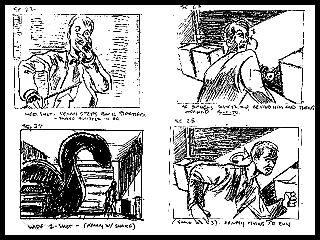 Storyboards are NOT FOR DIRECTORS! They aren't
some kind of crutch for filmmakers who can't
visualize what they want or think on their feet . Storyboards are a
valuable tool used to clearly
and precisely communicate to everyone else on the film exactly what will be seen on
screen. With storyboards everyone, the cinematographer, costumer, stunt
coordinator, effects supervisor, everyone, can see what's going on. This lets everyone do their job
better and gets us all in sync. Storyboards minimize mix-ups. When
working in separate units it allows you to see how the final shot you're doing fits
into a larger sequence or how much empty space to leave in the frame for the as
yet non-existence, giant, CGI snake that will be put in later.
Storyboards are NOT FOR DIRECTORS! They aren't
some kind of crutch for filmmakers who can't
visualize what they want or think on their feet . Storyboards are a
valuable tool used to clearly
and precisely communicate to everyone else on the film exactly what will be seen on
screen. With storyboards everyone, the cinematographer, costumer, stunt
coordinator, effects supervisor, everyone, can see what's going on. This lets everyone do their job
better and gets us all in sync. Storyboards minimize mix-ups. When
working in separate units it allows you to see how the final shot you're doing fits
into a larger sequence or how much empty space to leave in the frame for the as
yet non-existence, giant, CGI snake that will be put in later.
In a movie with a lot of effects you need to work out the way to do each shot in advance and in
detail. Is it going to be an on set mechanical effect? A CGI
element? A bluescreen shot? Do you need to shoot a background
plate? A model? A miniature? A puppet? Whatever, everyone needs to know
so we all show up working on the same movie.
This is not to say that you
always get exactly what you set out to get, or that things don't change when you get on set. We had
plenty of issues on Python, most relating to time and schedule, that made it impossible to
get the elements we wanted. This often left the effects people with their hands
tied and forced to come up with a compromise that lessened the quality of what they could
have done. But I know this -- we did a lot better
having storyboards then we would have done without them.
In selling the idea behind a
giant-killer-snake film like Python we felt the parts that mattered most
would be the main
"kill" sequences featuring the snake. We all wanted these scenes
to look convincing and knew they would
require the most coordination between the CGI department, the physical effects people
and regular production. We wanted to make those scenes work as best we
could since the big snake was the title character, our "star" if you
will, and he was what the movie was all about. As
always, time would be against us in shooting (18 days for the whole thing)
and the hope was that careful planning would allow us to know our needs exactly, work
efficiently and make a better movie.
Okay, so, things didn't always go as we planned, but these were the scenes we
wanted storyboarded, in full or in part, for Python.
These were to be our big money scenes.
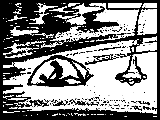
The Lake Attack |
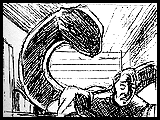
The Garage Sequence |
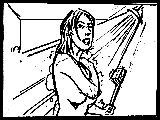
The Shower Sequence |
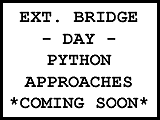
The Bridge Attack |
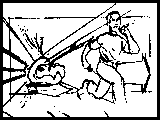
The Tunnel Chase |
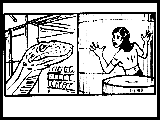
The Perfecto Plating Finale |
Three different storyboard artists worked on Python, each with a different
style, as you can see in the work that accompanies each sequence. If time
and budget had permitted we would liked to have storyboarded more. We only
had two weeks of official preproduction on Python, and most of
that was spent in
script rewrites, casting and finding locations. It really wasn't very much
time.
The Snake vs. Bicycle Chase Sequence - There was one other
sequence, never boarded (due to time) for an elaborately scripted Snake vs.
Bicycle chase that occurred after the bridge attack scene. If you've seen
the film you probably thought it was kinda strange and silly that they stop to
put on their safety helmets and goggles as they're fleeing for their very lives
from this giant snake.
The original idea was that we would get these professional stunt people to
double for our riders, then do this big ol' chase scene. We wanted to do some
of the most radical, really
hot, top-of-the-line, cutting-edge, daring bicycle stunts
ever seen on film. We scripted jumps and near vertical descents down steep hillsides,
incredible heart-in-your-throat stuff, all for the fun of the film and in order to
justify how in the world our heroes ever managed to escape that incredible,
deadly-fast, giant snake on their tails. The helmets were needed to hide
their faces so you wouldn't notice they were doubles. It's the same purpose served by Indiana Jones' amazing, never falls
off, always slightly over his face, hat in Raiders of the Lost Ark.
Well, we never had time to storyboard the sequence and were not able to find
a suitable location that was on our schedule and budget. Our hard working
second unit DID shoot some footage, some of it very good, but not enough for the
kind of big, elaborate sequence we needed, not in the time they had to do it,
not when they had to wait for us on first unit because they needed to use the
same bikes WE were using because we didn't have doubles.
In any case, never made it into the film and I wonder if we had storyboarded
it out, or had time to, if we could have worked it out in advance so we might
have been able to solve those problems, make a schedule that worked, or figured
out some kind of solution. I believe in preproduction and storyboards are
a big part of that, when you can get 'em.
As it worked out we went into production with several major sequences not boarded
at all or with boards that didn't reflect recent script changes. I
understand one of the problems for the effects people was that some of the
scenes did not have complete or accurate storyboards. My apologies to
them, they are hard workers and talented people and they deserved better than I
gave them.
Most storyboards were done prior to casting so don't look for any
physical resemblance to the characters other than in the broadest sense.
For the most part we tried to stick to the boards fairly closely. When we don't,
there is, of course, always a reason. Compare the storyboards here to the actual sequences in
the film and you notice some interesting differences. I've scribbled some
notes about where and why they differ.
[Storyboards not yet posted: please check back soon.]
 Storyboards are NOT FOR DIRECTORS! They aren't
some kind of crutch for filmmakers who can't
visualize what they want or think on their feet . Storyboards are a
valuable tool used to clearly
and precisely communicate to everyone else on the film exactly what will be seen on
screen. With storyboards everyone, the cinematographer, costumer, stunt
coordinator, effects supervisor, everyone, can see what's going on. This lets everyone do their job
better and gets us all in sync. Storyboards minimize mix-ups. When
working in separate units it allows you to see how the final shot you're doing fits
into a larger sequence or how much empty space to leave in the frame for the as
yet non-existence, giant, CGI snake that will be put in later.
Storyboards are NOT FOR DIRECTORS! They aren't
some kind of crutch for filmmakers who can't
visualize what they want or think on their feet . Storyboards are a
valuable tool used to clearly
and precisely communicate to everyone else on the film exactly what will be seen on
screen. With storyboards everyone, the cinematographer, costumer, stunt
coordinator, effects supervisor, everyone, can see what's going on. This lets everyone do their job
better and gets us all in sync. Storyboards minimize mix-ups. When
working in separate units it allows you to see how the final shot you're doing fits
into a larger sequence or how much empty space to leave in the frame for the as
yet non-existence, giant, CGI snake that will be put in later.




